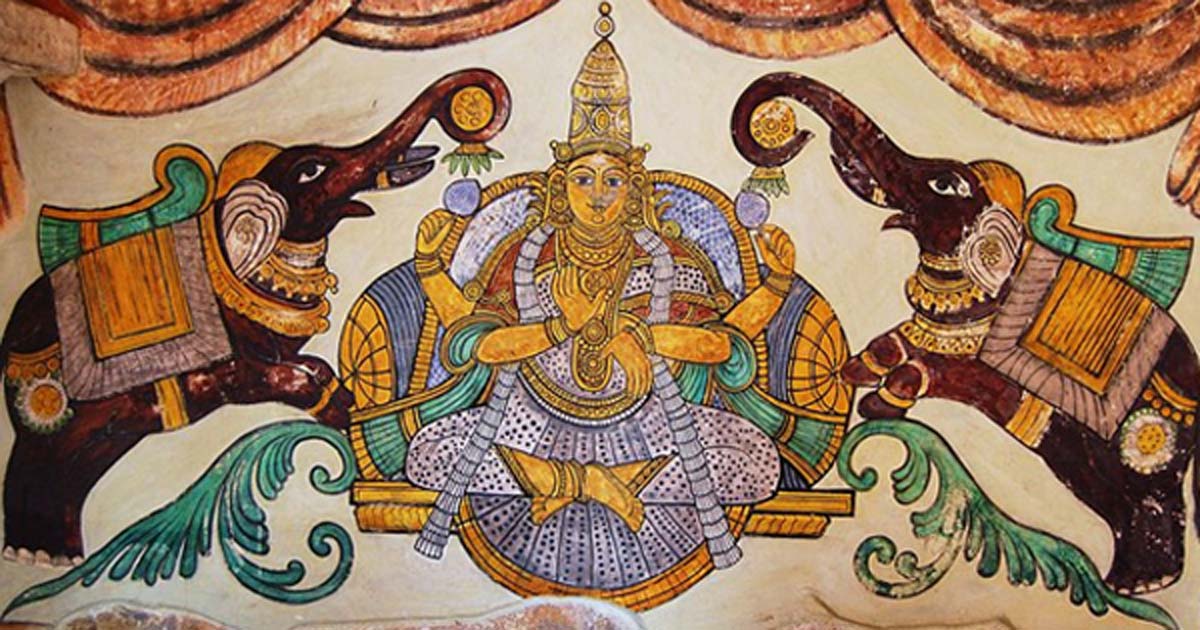Gold, the Peacock, the Lotus Flower, and Other Sacred Indian Symbols Explained
India is a very beautiful country and it has a culture full of symbolism. In what follows, some of the more popular Indian symbols are presented. These are some of the icons that are very relevant in revealing the nature of Indian culture.
The Importance of Gold in Indian Culture
Gold is very important in Indian culture, as it is a symbol of the goddess Lakshmi. She is considered a benevolent goddess; thus, it is believed that buying gold can bring a lot of luck to an individual.

The Goddess Lakshmi (1896) by Raja Ravi Varma. (Public Domain)
Owning gold has always represented a symbol of high social status and power. In the case of Indian weddings, gold brought as a dowry (called “Stridhan”) by the bride illustrates the social status of the family from which she comes.
- Beautiful Dynastic Artistry Shaped the Face of Modern India
- 10 Ancient Symbols You Think You Know the Meaning Of (But You Probably Don’t)
- Incredible Megaliths of India: Star Maps and Headless Goddesses – Part I
Gold is cherished because it is believed to bring luck and prosperity. It is also customary to decorate the statues of the gods with ornaments made out of gold in the Indian culture.
There are even special days in the Hindu calendar when it is said that it is better to buy gold. The gold bought on these occasions will supposedly bring more good luck to the individual than gold bought on other days of the year. The days are Dusshera, Dhanteras, Durga Puja, Pongal, and Onam. Women get dressed in very beautiful holiday clothes and they wear gold jewelry on these days.

A woman wearing gold jewelry. (CC0)
Gold is also given as a present at weddings, birthdays, and religious festivals. And because holiday clothes were previously mentioned, it must be said here that India has one of the top industries in regard to making materials and cloth. Clothes for special occasions are embroidered with gold thread. These are valued not only in India, but also on an international level. Thus, gold constitutes a very important symbol in Indian culture and it is appreciated so much that to lose gold might be seen as the beginning of much sorrow or misfortune.
The Peacock
The peacock is the national bird of India. It represents the succession of temporal cycles in Hindu cosmogony. In addition to this, it is believed that its feathers bring prosperity and, if they are kept inside the house, they keep flies out. It is also said that the peacock’s screech can warn people of possible danger. According to Hindu religious beliefs, the peacock was created from one of the feathers of the mythological bird Garuda. This was a huge majestic bird which carried Lord Vishnu on its back.
The peacock is also thought to promote good mental health because looking at it can mentally calm an individual down. There are also many legends regarding peacocks. For example, it is said that the god Indra turned himself into a peacock once and the god Krishna always carried a peacock feather in his crown.

An Indian peacock displaying its tail plumage. (Vidnaray/CC BY SA 3.0)
The Lotus Flower
The lotus flower is the national flower and the most venerated flower of India. It is seen as a symbol of perfection, creation, and beauty. It is often mentioned in relation to the chakras and the gods Brahma, Vishnu, and Lakshmi. Because it comes out of the mud from the bottom of lakes but is always clean and beautiful, this flower ended up representing purity.
In addition, it also represents a lack of attachment towards the material world. Traditionally, it is said to show people to work more, but never become too attached to material things because they are just passing through life. In regard to the association with various gods, the creator divinity Brahma always meditates on a lotus flower.

Brahma, Vishnu and Shiva seated on lotuses with their consorts, Saraswati, Lakshmi and Paravati respectively. ca 1770. Guler, India. (Public Domain)
The Banyan Tree
The Banyan tree, Vata, is often planted in front of Indian temples. This tree represents the Hindu creator Brahma and it is a highly venerated tree in India. It also symbolizes the Hindu Trinity. In this context, the bark of the Banyan tree is linked to the god Vishnu, its roots are a symbol of Brahma, and its branches represent Shiva. The roots of this tree grow in all directions, including above ground. Traditional Hindu belief states that Shiva stayed under this type of tree to reach enlightenment.
- The Forgotten Stepwells: Thousands of Masterpieces in Engineering, Architecture and Craftsmanship Provide a Window into India’s Past
- The Double-Headed Eagle: An Everlasting Symbol of Power
- 2000 Year Old Labyrinth Uncovered in India Shows Same Pattern as a Greek Maze from 1200 BC
It is also said that various gods and spirits make their homes in these trees. The Banyan tree is considered the “Tree of Immortality” and it represents benevolent rulers and those who take very good care of their families. This tree is never cut in India.

Banyan tree at Ranthambore National Park. (Shrinivas Patil/CC BY SA 4.0)
The AUM Symbol
The AUM symbol represents the true reality of the universe, being the most important Hindu symbol. It is said that AUM might have been the first sound that was ever heard in the created universe. AUM is a basic mantra which represents the three divine aspects of the Hindu religion: ‘A’ is Brahma, ‘U’ is Vishnu, and ‘M’ is Shiva.

AUM (Om), a symbol in Hinduism. (Public Domain)
Top Image: A painting of Lakshmi on the inner walls of the Tanjore Big temple. Gold is said to symbolize this goddess. Source: Ankushsamant/CC BY SA 3.0
By Valda Roric
References:
Valda Roric – “From History to Mystery”
Valda Roric – “Wonders of History and Mythology”
George M. Williams – “Handbook of Hindu Mythology”
Devutt Pattanaik – “Indian Mythology”
Wendy Doniger – “Hindu Myths”



















